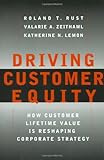Driving Customer Equity : How Customer Lifetime Value is Reshaping Corporate Strategy
In their efforts to become more customer-focused, companies everywhere find themselves entangled in outmoded systems, metrics, and strategies rooted in their product-centered view of the world. Now, to ease this shift to a customer focus, marketing strategy experts Roland T. Rust, Valarie A. Zeithaml, and Katherine N. Lemon have created a dynamic new model they call “Customer Equity,” a strategic framework designed to maximize every firm’s most important asset, the total lifetime value of its customer base. The authors’ Customer Equity Framework yields powerful insights that will help any business increase the value of its customer base. Rust, Zeithaml, and Lemon introduce the three drivers of customer equity — Value Equity, Brand Equity, and Retention Equity — and explain in clear, nontechnical language how managers can base their strategies on one or a combination of these drivers. The authors demonstrate in this breakthrough book how managers can build and employ competitive metr
List Price: $ 53.00
Price: $ 18.02
Few More:
 Essential: All About CRM – Customer Relationship Management !
Essential: All About CRM – Customer Relationship Management !Essential: All About CRM – Customer Relationship Management !A collection of selected reports -CRM And What It Has Done For Consum…
 CRM at the Speed of Light, Fourth Edition: Social CRM 2.0 Strategies, Tools, and Techniques for Engaging Your Customers (Unknown Series)
CRM at the Speed of Light, Fourth Edition: Social CRM 2.0 Strategies, Tools, and Techniques for Engaging Your Customers (Unknown Series)A social revolution in how we communicate has taken place in recent years. Smartphones, social web tools, and the instant availabi…
 Customer Relationship Management (Briefcase Books Series)
Customer Relationship Management (Briefcase Books Series)This reader-friendly series is must read for all levels of managers All managers, whether brand-new to their positions or well …
 Customer Relationship Management
Customer Relationship Management“Customer Relationship Management” (CRM) introduces the management philosophy of CRM. This is the first book to explore the benefi…


A Useful Tool for Marketing and Communications Managers,
Many marketing executives are challenged to evaluate the impact of their marketing communications and customer relationship strategies, but too often get bogged down in short-term measures like click-throughs and direct response. Driving Customer Equity is a valuable tool for quantifying the long-term impact of investments in building a brand and improving customer satisfaction. It is based on a logical framework that recognizes the financial returns from building brand equity, improving perceived value and increasing customer satisfaction. The book does more than provide a useful framework and report real research. It also includes hands-on tools that can be used by managers, consultants and researchers. I am recommending this book to all of my clients in the hope that it encourages a long-range focus that recognizes building customer equity is more important than short-term sales.
Was this review helpful to you?

|Customer Equity: Moves the reader fom consepts to numbers,
I approached this book as a heavy consumer of marketing literature in general and customer lifetime value literature specifically. Based on previous readings my expectations were low. However, the book’s basic messages pertaining to customers not products, services not products, identifying the three drivers of customer equity and finally, how to estimate the numbers fascinated me. Through Customer Equity the reader can learn about some of the fundamentals behind what drives a company’s profitability. CEOs are not concerned about the 4P’s of marketing. Their focus is on the overall recourses allocation in order to secure future revenue from current and future customers. This book recognizes this and provides the reader with a roadmap to the allocation of the marketing budget among three main drivers of customer equity, i.e. brand equity, value equity or retention equity. Customer Equity provides the reader with sophisticated tools to estimate the financial consequences of the alternatives before they are executed. The ability to estimate the impact of improvement in any of the three areas on customer equity, will in my mind regain marketers access to the CEO -an access they lost to finance and strategy in the 1980s. In an era influenced by customer relationship management thinking, Customer Equity is a must reader for enlightened managers.
Was this review helpful to you?

|Concerned about equity in Delaware,
This is a very insightful book that makes you think about different approaches to a traditional problem. How do you continue to grow your company and increase your profits? The authors focus on Brand Equity, Retention Equity, and Value Equity. They suggest new ways to think about and manage your company to make sure you are focusing on the right things in this new high speed marketplace. This is an important book for any marketing professional who wants to stay abreast of the latest thinking and strategies to increase customer retention and value.
Was this review helpful to you?

|